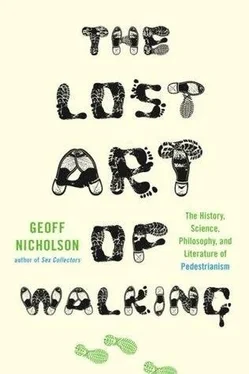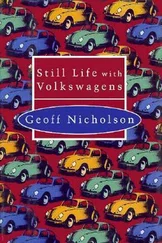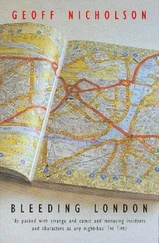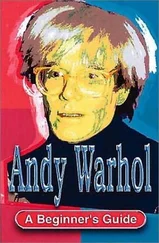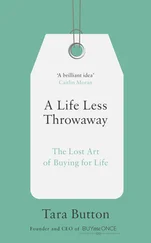Oxford Street is a thoroughfare running more or less east-west. The big department stores are on the north side, the sunny side of the street — De Quincey’s druggist was on the sunless south side. It’s the street where William Blake walked on his way to and from his house on Poland Street. It was the subject of a movie by Malcolm McLaren, and the site of one of the Sex Pistols gigs, at the Hundred Club. It’s also a street where I once saw Bob Geldof walking along weighed down with his Christmas shopping.
It became Oxford Street only after 1713. Until then it was variously known as the Road from Uxbridge, the King’s Highway, the Acton Road, Tyburn Way — the Tyburn being a river that still runs not so very deep beneath the street surface. In 1941 a German bomb made a crater that briefly exposed it.
Tyburn was also the place of public executions, at the very western end of Oxford Street, nearly but not quite where Marble Arch now stands. Hangings were regular, communal, celebratory activities. Prisoners were brought on horse-drawn cart from Newgate Prison a few miles away in the City of London, and eventually along the length of the street while large crowds followed on foot. To walk along Oxford Street is to walk the route of fifty thousand convicted criminals who were executed at Tyburn and those who liked to watch.
Tom Waits mentions the Tyburn Jig, the ‘dance’ of the flailing legs of the hanged who won’t be walking anywhere ever again. In fact a small paper could be written on Tom Waits and walking. In the song ‘Whistle Down the Wind’ he refers to something called the ‘Marley Bone Coach’ — that’s how it’s spelled on his website. Now, Marylebone is a district of London, no distance from Oxford Street, and I don’t doubt there was once, probably still is, a coach that goes there, but the phrase ‘taking the marrow bone coach’ is, or was, slang for walking, i.e., using the marrow bones in the legs. I’d like to think Waits is aware of this. In another song he warns that when you walk in the garden you’d better watch your back.
Most of my walking on Oxford Street was not done entirely by choice. I’d worked two jobs on the street and two more close by. Consequently, when I went out for a walk at Iunchtime I found myself on Oxford Street. My bank was there. I bought food there. I bought clothes, books, records, spectacles. The truth was, despite everything, I rather enjoyed walking there, and yet I could see there was something troubling and paradoxical in having done so much walking in a place that was held in such contempt by so many. I felt that Oxford Street needed to be redeemed. I thought it might be a good place to do my particular strange walking project.
I came to a decision. I would make six transits of Oxford Street, there and back, from Tottenham Court Road tube station at the east end of the street to Marble Arch at the west, and back again. I would spread them out over the course of the day. I would see how the street and my walking changed.
The Oxford Street Shopping Association claims the street is a mile and a half long (though I suspect this is an optimistically high figure), so each round-trip would theoretically be three miles, for a total of eighteen. A few unexpected detours and diversions, plus the short distances between the start and finish of the walks, would surely make it add up to twenty miles. That seemed satisfyingly like hard work.
Why six transits? Partly because I was trying to work up a pun about ‘sic transit Gloria’, but mostly because I was doing the walk on the sixth day of the sixth month of 2006. There were reports in the papers about this date having some relation to the number of the beast, 666, but I couldn’t see that. No reasonable way of writing the date could be made to give you that bestial number. In any case, one of the notions being bandied about was that this would be the day the Anti-Christ was born, which in itself didn’t seem to threaten much, at least for the time being. Even the Anti-Christ surely wouldn’t hit his stride on the very day he was born.
During the course of the day I duly walked the length of Oxford Street six times in each direction and did my eighteen to twenty miles. I set off for the first walk at six in the morning, in bright sunlight, and I completed my last walk a little before midnight.
I walked the street when it was all but empty and when it was so packed that I could scarcely walk at all. Chiefly I saw other people: first the workers, then the shoppers, and finally the carousers and drunks and lovebirds.
At times there was something festive about it all. The weather was as good as English weather ever gets. The people on the street looked as though they were enjoying themselves. Many looked like tourists, and many of them seemed lost. A lot of maps were being consulted, and lots of photographs were being taken. I saw one man scanning the street with binoculars. A woman in full, engulfing Arab dress was wielding a video camera. The crowd was diverse in terms of race, age, and class. They wouldn’t all be going to the same shops or buying the same things or spending the same amount of money, but they were all there to buy something , whether designer clothes or cheap T-shirts with a map of the London underground on them. They were united, made homogenous by the great equalizer of trade, and they all looked essentially happy about it.
I was hassled occasionally, once by a young man in a red T-shirt, smiling far too broadly, who stepped in front of me and demanded, ‘Do you have love in your heart?’ I couldn’t stop myself guffawing at the question. ‘I think you know I haven’t’, I said. That made him lose a lot of his charm. ‘This is a very serious issue’, he said very seriously, which I didn’t dispute. He was raising funds for a children’s charity, a worthy cause as far as I know, and no doubt there is some research proving that asking dumb questions of people who are walking down Oxford Street is a good way to suck in money, but I was the wrong demographic.
‘Does this ever work?’ I asked as I walked away.
‘Yes’, the young man called after me earnestly. ‘Yes, it does’.
Later, outside Marble Arch tube station two young Muslim men were standing behind a stall decked out with leaflets and hand-labeled DVDs. One asked me, ‘Now, what’s your understanding of Islam?’ He had the winning smile and the steady, open gaze favored by the more appealing sort of zealot, and I said I didn’t really have any understanding of it at all. He asked me if I had a DVD player, and offered me a DVD. I said I’d rather have something written. ‘Ah’, he said, ‘you want the original ’.
I ended up with two publications, one called ‘Jesus, peace be upon him, a concise Islamic Belief’, and a booklet titled ‘Muhammad’s Prophethood: an analytical view’, by Jamal A. Badawi, professor of business management at St. Mary’s University, Halifax, Canada. Badawi is very insistent that Muhammad was not an epileptic, nor did he suffer from ‘the falling down disease that was known to his contemporaries’.
A minute after I’d left the Islamic boys, I encountered a Christian preacher, an American from his accent, shouting through a megaphone, asking whether I, or anyone else, wanted to know about heaven. He certainly hadn’t perfected the winning smile and the steady gaze. I, and everyone else, looked away and walked on.
Halfway through the afternoon I noticed a fragmentation, people displaying tribal affiliations: retro punks, a pair of Japanese women in kimonos, some Hare Krishna celebrants, and a group of four particularly nasty-looking young skinheads. Not quite skinheads, actually — they’d left odd patches of velvety hair here and there on their skulls and had them razored into hard-edged geometrical patterns. This wasn’t the style of authentic English skinheads I was familiar with, and when I heard the boys’ German accents I was relieved. It seemed to explain something. And even if the prospect of German skinheads was ultimately no more reassuring than that of English skinheads, I felt some consolation in knowing they were no part of any tribe I remotely belonged to.
Читать дальше
